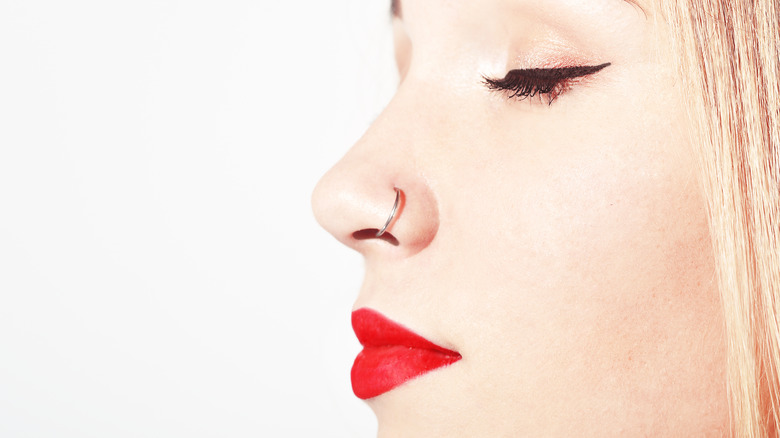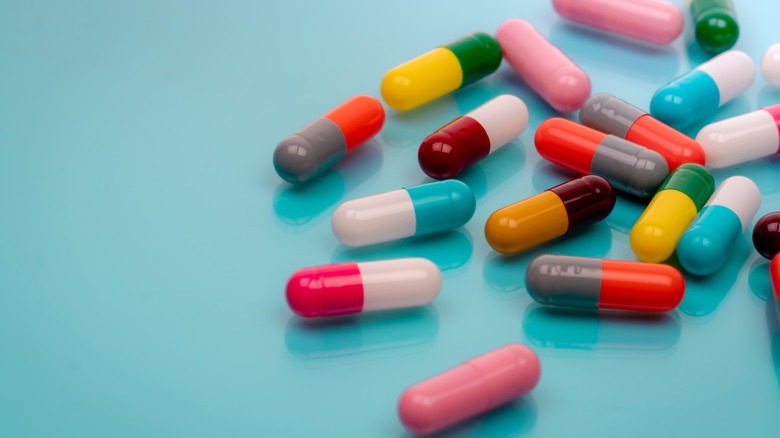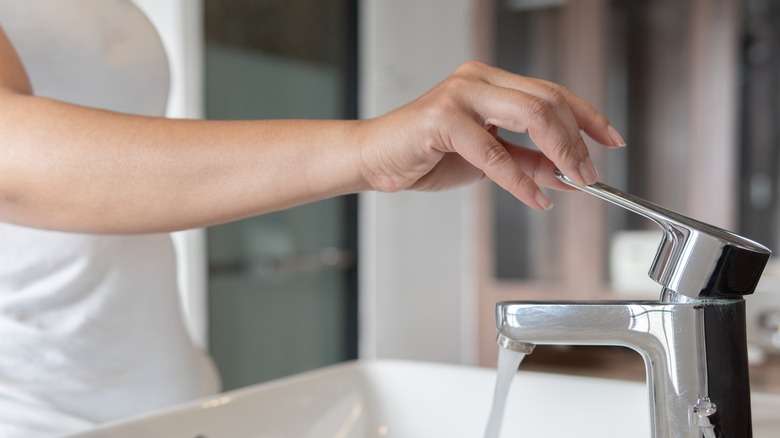How To Get Rid Of A Nose-Piercing Bump
There's a lot to consider when getting a nose piercing — you'll have to consider the risks and complications associated with nose piercings. According to WebMD, the nose is typically pierced in three major areas: the nares (the flesh around the nostrils), the septum (the tough cartilage between the nostrils), and the soft flesh beneath the septum (right under the cartilage).
If you already have a nose piercing, redness, swelling, and bleeding are common in or around the piercing site (via Healthline). The area might also be itchy, with a crust forming around the jewelry and pus coming out of the piercing site, says Healthline. According to the source, healing is determined by the type of piercing. Nostril or nose piercings, for example, take between four and six months to heal, depending on the jewelry you wear. A thicker gauge ring or stud might take more time to heal than a nostril with a thin ring.
Sometimes, for many different reasons, a bump can also arise from a nose piercing, and in such instances, many wonder how to get rid of it. According to MedicalNewsToday, these bumps can be round and raised and might be itchy or tender to the touch. There are various causes for these bumps, and the treatment options will vary based on the cause.
Possible causes of nose-piercing bumps
According to Healthline, a nose-piercing bump is generally one of the following three: a granuloma, a keloid scar, or a pustule.
A granuloma, as described by the Mayo Clinic, refers to a small area of inflammation. In most cases, granulomas are benign or noncancerous. While they're usually seen in the lungs, granulomas can occur in other body parts and the head says the clinic. In some cases, granulomas occur as a defense mechanism to keep external invaders such as fungi and bacteria from spreading.
A pustule is a bulging patch on the skin containing yellowish pus that tends to show up when you have some sort of infection, says WebMD. When your nose piercing is done in unsanitary conditions or isn't regularly cleaned, you stand a chance of getting an infection that can cause bumps, says MedicalNewsToday.
MedicineNet describes a keloid as a scar that develops on the skin after a skin injury. According to the source, a keloid might appear purple initially and dark later, often due to an excessive scar tissue formation on your skin, even after your wound has healed. MedicineNet states that a keloid generally doesn't subside on its own, so you'll need to contact a dermatologist to remove it.
In the view of Healthline, allergies can also cause bumps. Using jewelry made from nickel can cause a reaction with your skin, leaving you with bumps. The source recommends jewelry made from niobium, titanium, stainless steel, or 18- or 24-carat gold if you react to nickel.
Best practices to prevent a nose-piercing bump
Although you can treat nose-piercing bumps, you can also prevent them from occurring.
First, be sure to use an experienced piercing studio. According to Healthline, a reputable piercing facility will usually have the appropriate licenses and permits.
Proper aftercare is another preventative measure. While the nose piercing process is quick, healing can take several months. According to Healthline, piercing aftercare will set the tone for healing, therefore, it should be done correctly. Some aftercare tips include cleaning the site at least twice a day, moisturizing the affected area with tea tree oil or coconut oil, and using unscented soap to gently clean the site (via Healthline). Also, before touching your nose, WebMD advises always washing your hands.
Cleaning your piercing should be done with instructions from your piercing studio. As mentioned by WebMD, there are some general cleaning guidelines. The source advises using clean gauze or paper towels to clean the pierced area on your nose. Healthline adds that you must saturate the paper towel with saline solution. If you prefer to use soap for cleaning, Healthline suggests that you rinse the piercing area thoroughly, ensuring there's no trace of soap left behind.
To prevent microbes from entering the pierced area, WebMD advises against swimming in pools since swimming pools harbor all kinds of bacteria. Healthline also advises against picking your nose piercing. Keep your hands as far from your nose piercing as possible, the source offers, as this will reduce your chances of having an infection.
Medical treatment options
Nose piercing bumps will require different treatment options, depending on the cause. Your treatment might vary from simple home remedies to full-blown medical assistance. One treatment option is antibiotics, which are important if the area is infected, says the National Health Service (NHS). You might be given antibiotics in the form of tablets, creams, or ointments. MedicalNewsToday describes antibiotics as medications that destroy or slow down the growth of bacteria in an affected part of our bodies. According to the source, antibiotics treat diseases caused by bacteria, and some side effects include an upset stomach, diarrhea, and nausea.
If a keloid is the cause of your nose piercing, corticosteroid injections, retinoid creams, and a laser will help treat a bump caused by a keloid. According to MedicineNet, corticosteroid injections might be administered directly into your keloids to help soften and shrink them. You might need a couple of shots to get your desired results, says the source. Retinoid creams, on the other hand, reduce the itching of bumps as well as their size, while lasers reduce not just size and redness but also the discoloration of the keloid.
At-home treatments for a nose-piercing bump
When treating a nose-piercing bump, it's best to visit your doctor to understand the main cause. For cases that aren't serious, you might be able to treat the condition with various home remedies. According to MedicalNewsToday, applying a warm compress will keep the pierced area clean and help prevent tissue damage and the onset of infections that cause the bump in the first place. Start by soaking a clean washcloth in a bowl of hot water. Squeeze the towel, and apply it to the piercing, holding it still with a little pressure for some minutes.
Tea tree oil is another effective at-home remedy. According to Healthline, it has antimicrobial, anti-inflammatory, and antiseptic properties that make it an integral part of piercing aftercare. You can use tea tree oil both during the initial healing process and for the long term to prevent infections and minimize irritation. Despite the effective properties of tea-tree oil, Healthline advises against using it as a replacement for cleaning your piercing. Rather, tea tree oil must be used as a complementary treatment.
According to MedicalNewsToday, a sea salt solution can help keep the piercing area clean, reduce any swelling, and promote faster healing. To make a sea salt solution, they suggest dissolving ⅛ to ¼ of a teaspoon of salt in a cup of warm bottled or distilled water. Rinse your piercing area with the solution and then dry it gently.
When to see a doctor
According to the Mayo Clinic, no matter the kind of piercing, there's a risk of certain complications. Ideally, home remedies should reduce your piercing bump's size, redness, and swelling. There are, however, some instances where you'll need immediate medical attention — this is usually when the bump is infected.
If the equipment used for piercing is contaminated with infected blood, bloodborne diseases (such as HIV, hepatitis B, hepatitis C, or tetanus) can occur. According to WebMD, it's vital to see a doctor if you notice any signs of an infection, including a sudden onset of fever, redness, swelling, or very painful skin around your piercing. Also, if you notice any yellow or green fluid oozing from your nose piercing, it's a sign of an infection.
Although irritation and inflammation are common after a nose piercing, these symptoms usually improve within a week, says MedicalNewsToday. If your symptoms persist after two weeks, or you experience an uncomfortable amount of pain, MedicalNewsToday suggests reaching out to your doctor for treatment.






